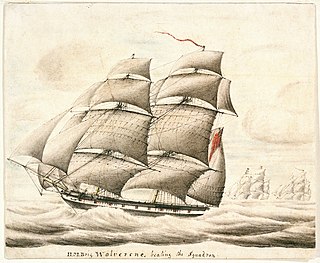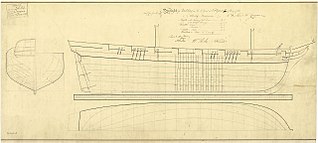
HMS Euryalus was a Royal Navy 36-gun Apollo-class frigate that saw service in the Battle of Trafalgar and the War of 1812. During her career she was commanded by three prominent naval personalities of the Napoleonic and post-Napoleonic period: Henry Blackwood, George Dundas and Charles Napier. After the end of the Napoleonic Wars she continued on active service for a number of years, before spending more than two decades as a prison hulk. She ended her career in Gibraltar where, in 1860, she was sold for breaking up.

HMS Cherub was an 18-gun Royal Navy Cormorant-class sloop built in Dover in 1806. She participated in two major campaigns in the West Indies during the Napoleonic Wars, and one major engagement in the Pacific during the War of 1812, all each of which earned her crews clasps to the Naval General Service Medal. The Navy sold her in 1820.

Franchise was launched in 1798 as a 40-gun Coquille-class frigate of the French Navy. The British captured her in 1803 and took her into the Royal Navy under her existing name. In the war on commerce during the Napoleonic Wars she was more protector than prize-taker, capturing many small privateers but few commercial prizes. She was also at the battle of Copenhagen. She was broken up in 1815.
HMS Hesper was a British Royal Navy 18-gun ship-sloop of the Cormorant class, launched in 1809 at Dartmouth. Her original builder, Benjamin Tanner, became bankrupt during her construction, so John Cock completed her. In 1810 she was reclassed as a 20-gun sixth-rate ship ; in 1817 she was again re-rated, this time as 26 guns. She served primarily in the Indian Ocean. In 1810 she participated in the Invasion of Isle de France. The next year Hesper participated in the capture of Java, which she followed in 1812 by capturing Timor. She was sold in 1817.

HMS Wolverine was a Royal Navy 18-gun Cruizer-class brig-sloop, launched in 1805 at Topsham, near Exeter. Early in her career she was involved in two fratricidal incidents, one involving a British frigate and then a newsworthy case in which she helped capture a British slave ship. She later captured a small naval vessel and several privateers, and took part in the invasion of Martinique, and during the War of 1812, in the attack on Baltimore. Wolverine was decommissioned in August or September 1815 and was sold on 15 February 1816.

HMS Hazard was a 16-gun Royal Navy Cormorant-class ship-sloop built by Josiah & Thomas Brindley at Frindsbury, Kent, and launched in 1794. She served in the French Revolutionary Wars and throughout the Napoleonic Wars. She captured numerous prizes, and participated in a notable ship action against the French frigate Topaze, as well as in several other actions and campaigns, three of which earned her crew clasps to the Naval General Service Medal. Hazard was sold in 1817.
HMS Amaranthe was an 18-gun Royal Navy Cruizer-class brig-sloop built by John Dudman at Deptford Wharf and launched in 1804. She served in the Caribbean, taking part in an action and two campaigns that gained those members of her crew that survived until 1847 the NGSM. She was sold in 1815.
HMS Talbot was a British Royal Navy 18-gun sloop-of-war built by James Heath & Sons, of East Teignmouth, and launched in 1807. Perhaps her greatest accomplishment was the reversal of the liberation of Iceland that the colorful, erratic, former Royal Navy seaman and privateer Jørgen Jørgensen had carried out. Talbot was sold in 1815 for mercantile service. Renamed George, she interspersed several voyages to Ceylon and India with three voyages as a whaler in the British southern whale fishery. She was last listed in 1831.

HMS Success was a 32-gun Amazon-class fifth-rate frigate of the British Royal Navy launched in 1781, which served during the American Revolutionary, French Revolutionary and Napoleonic Wars. The French captured her in the Mediterranean on 13 February 1801, but she was recaptured by the British on 2 September. She continued to serve in the Mediterranean until 1811, and in North America until hulked in 1814, then serving as a prison ship and powder hulk, before being broken up in 1820.

HMS Superieure was the French privateer Supérieure, which was built in 1801 in Baltimore, Maryland, and which the British captured in 1803 in the West Indies, and took into the Royal Navy. She spent most of her career on the Jamaica and Leeward Islands stations, where she captured numerous privateers. She participated in several notable single-ship actions, including one in which she harassed a frigate, and two campaigns that would, in 1847, earn her surviving crew members the Naval General Service Medal (NGSM). She was laid-up in Britain in 1810 and sold in 1814.

HMS Scylla was an 18-gun Cruizer-class brig-sloop of the Royal Navy. The first to bear the name Scylla, she was launched in 1809 and broken up in 1846.

HMS Pandora was launched in 1806. She captured two privateers before she was wrecked in February 1811 off the coast of Jutland.

HMS Swallow was a Cruizer-class brig-sloop launched in December 1805, nine months late. She served the Royal Navy through the Napoleonic Wars, capturing numerous privateers. After the end of the wars she was broken up in 1815.

HMS Moselle was a Cruizer-class brig-sloop of the Royal Navy, launched in 1804. She served during the Napoleonic Wars in the Mediterranean, the Caribbean, and the North American station. She was sold in 1815.

HMS Crocus was the nameship of the Crocus-class brig-sloops of the Royal Navy. She was launched in 1808 and had an almost completely uneventful career until she was sold in 1815. She then became a merchantman trading with the West Indies and the Mediterranean. She was last listed in 1823.
HMS Port d'Espagne was a 14-gun vessel, variously described as a sloop, gun-brig or schooner, built in 1806 in Trinidad, whose citizens presented her to the crown. She captured several small Spanish privateers and participated in a major campaign before she was sold in 1811.

HMS Harpy was a Royal Navy Diligence-class brig-sloop, launched in 1796 and sold in 1817. She was the longest lived vessel of her class, and the most widely travelled. She served in both the battle of Copenhagen and the British invasion of Java, took part in several actions, one of which won for her crew a clasp to the Naval General Service Medal, and captured numerous privateers. The Navy sold her in 1817.
HMS Saint Christopher was the French privateer Mohawk, launched in 1805, that the Royal Navy captured in 1806. The citizens of Saint Kitts, purchased her and donated her to the Royal Navy. She was broken up at Antigua in 1811.

HMS Albacore was launched in 1804 in Bristol. She participated in two notable actions. The British Royal Navy sold her in 1815 and she became a merchantman, sailing out of Guernsey. She was lost on 12 October 1821 while sailing from Buenos Aires to Barbados.
HMS Favorite was an 18-gun Cormorant-class ship-sloop, launched in 1806 and broken up in 1821. In her career she sailed as far North America, the Caribbean, Africa, South America, and the Far East. She captured or recaptured several merchant ships and a handful of privateers.

















